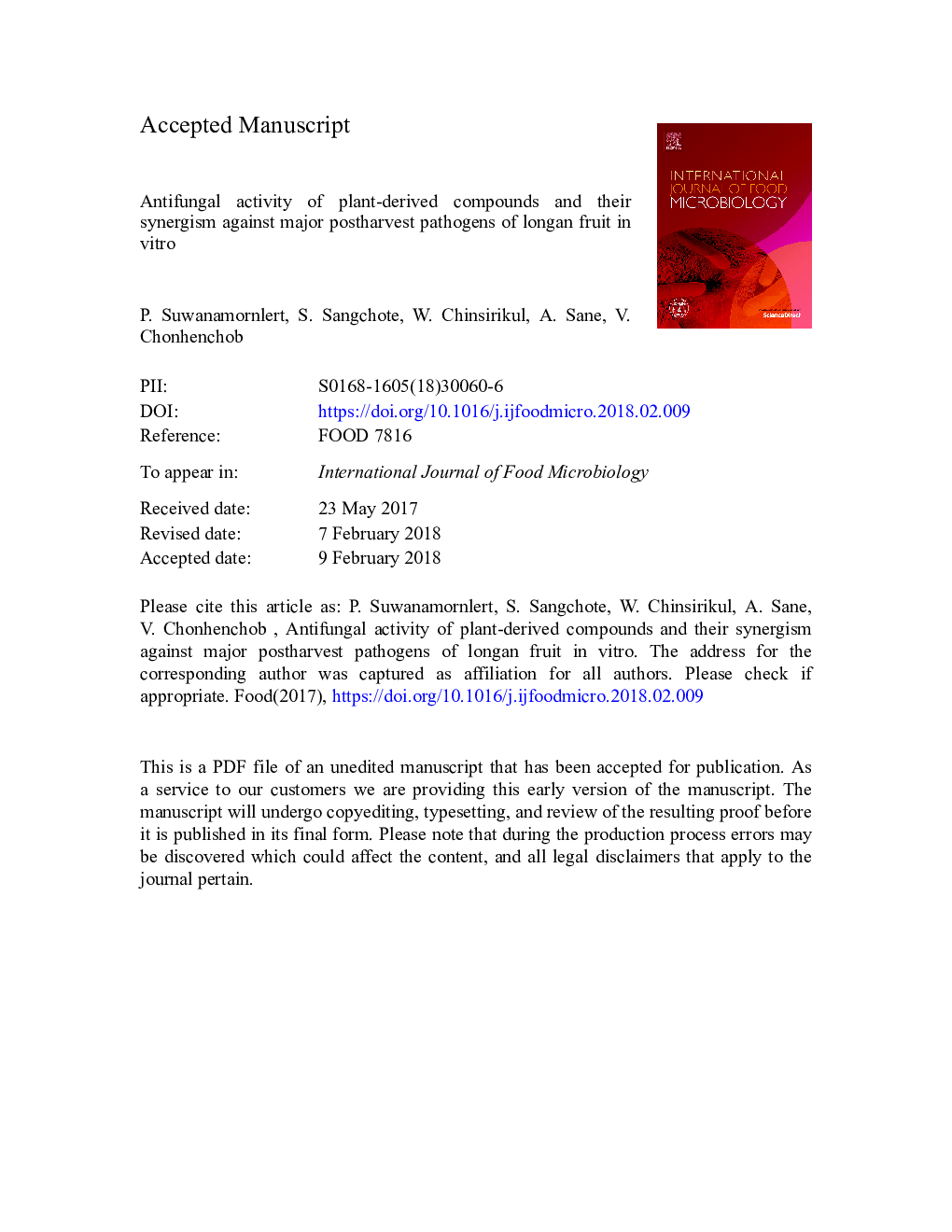| کد مقاله | کد نشریه | سال انتشار | مقاله انگلیسی | نسخه تمام متن |
|---|---|---|---|---|
| 8844238 | 1616512 | 2018 | 30 صفحه PDF | دانلود رایگان |
عنوان انگلیسی مقاله ISI
Antifungal activity of plant-derived compounds and their synergism against major postharvest pathogens of longan fruit in vitro
ترجمه فارسی عنوان
فعالیت ضد قارچی ترکیبات مشتق شده از گیاه و ترکیب آنها با پاتوژن های مهم بعد از گلدهی میوه لانگان در شرایط آزمایشگاهی
دانلود مقاله + سفارش ترجمه
دانلود مقاله ISI انگلیسی
رایگان برای ایرانیان
کلمات کلیدی
موضوعات مرتبط
علوم زیستی و بیوفناوری
علوم کشاورزی و بیولوژیک
دانش تغذیه
چکیده انگلیسی
The aim of this study was to find alternatives to conventional synthetic fungicides to control postharvest decay of longan fruit. The antifungal potential of thymol, carvacrol and trans-cinnamaldehyde was evaluated against four major longan pathogens, Lasiodiplodia spp., Phomopsis spp., Pestalotiopsis spp. and Geotrichum candidum, using vapor phase and direct contact methods. The vapor phase of all active compounds was more effective on fungal growth than direct contact. A volatile vapor of thymol and carvacrol had strong antifungal activity against the tested fungi, exhibiting minimum inhibitory concentration (MIC) in the range of 40 to 80â¯mg/L air; trans-cinnamaldehyde showed the least efficiency, with MIC ranging from 80 to 160â¯mg/L air for G. candidum and Phomopsis spp., while it could not inhibit Lasiodiplodia spp. and Pestalotiopsis spp. at 160â¯mg/L air. The minimum fungicidal concentration (MFC) of thymol and carvacrol varied from 40 to 80â¯mg/L air, while trans-cinnamaldehyde completely inhibited the mycelial growth of the tested fungi at higher concentrations. Mycelial growth of all tested fungi decreased with increasing active compound concentration, except for trans-cinnamaldehyde. Thymol proved to be the most effective compound against the four tested fungi, with effective concentration 50 (EC50) of 5.68â¯Â±â¯0.59, 6.86â¯Â±â¯0.52, 8.27â¯Â±â¯0.22 and 9.99â¯Â±â¯1.28â¯mg/L air for Lasiodiplodia spp., Phomopsis spp., Pestalotiopsis spp. and G. candidum, respectively. Fungal growth curves were adequately fitted (0.958â¯<â¯R2â¯<â¯0.996) by a modified Gompertz model. For all tested fungi, the lag phase (λ) of fungal mycelia exposed to thymol and carvacrol increased, while the maximum colony diameter (A) and maximum growth rate (vm) decreased. A combination of thymol and carvacrol exhibited an antagonistic effect against G. candidum but an indifferent effect against Lasiodiplodia spp., Phomopsis spp. and Pestalotiopsis spp.
ناشر
Database: Elsevier - ScienceDirect (ساینس دایرکت)
Journal: International Journal of Food Microbiology - Volume 271, 20 April 2018, Pages 8-14
Journal: International Journal of Food Microbiology - Volume 271, 20 April 2018, Pages 8-14
نویسندگان
P. Suwanamornlert, S. Sangchote, W. Chinsirikul, A. Sane, V. Chonhenchob,
